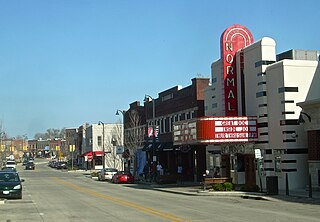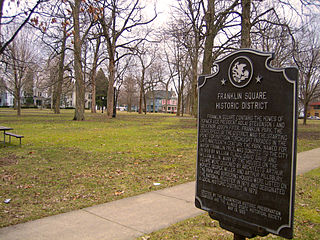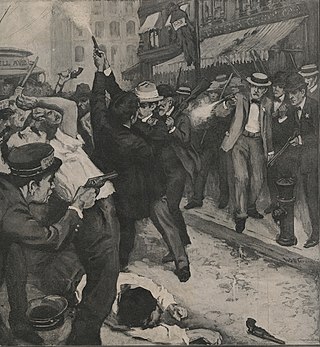
Bloomington is a city in and the county seat of McLean County, Illinois, United States. It is adjacent to the town of Normal, and is the more populous of the two principal municipalities of the Bloomington–Normal metropolitan area. Bloomington is 135 miles (217 km) southwest of Chicago and 162 miles (261 km) northeast of St. Louis. The 2020 census showed the city had a population of 78,680, making it the 13th-most populated city in Illinois and the fifth-most populous outside the Chicago Metropolitan Area. Combined with Normal, the twin cities have a population of roughly 130,000. The Bloomington area is home to Illinois Wesleyan University and Illinois State University. It also serves as the headquarters for State Farm Insurance and Country Financial.

Normal is a town in McLean County, Illinois, United States. As of the 2020 census, the town's population was 52,736. Normal is the smaller of two principal municipalities of the Bloomington–Normal metropolitan area, and Illinois' seventh most populous community outside the Chicago metropolitan area. Chris Koos has been Normal's mayor since 2003.

The Amalgamated Transit Union (ATU) is a labor organization in the United States and Canada that represents employees in the public transit industry. Established in 1892 as the Amalgamated Association of Street Railway Employees of America, the union was centered primarily in the Eastern United States; today, ATU has over 200,000 members throughout the United States and Canada.

Streetcars in New Orleans have been an integral part of the city's public transportation network since the first half of the 19th century. The longest of New Orleans' streetcar lines, the St. Charles Avenue line, is the oldest continuously operating street railway system in the world. Today, the streetcars are operated by the New Orleans Regional Transit Authority (RTA).

The Alton Railroad was the final name of a railroad linking Chicago to Alton, Illinois; St. Louis, Missouri; and Kansas City, Missouri. Its predecessor, the Chicago and Alton Railroad, was purchased by the Baltimore and Ohio Railroad in 1931 and was controlled until 1942 when the Alton was released to the courts. On May 31, 1947, the Alton Railroad was merged into the Gulf, Mobile and Ohio Railroad. Jacob Bunn had been one of the founding reorganizers of the Chicago & Alton Railroad Company during the 1860s.

Franklin Square, or Franklin Park is located in Bloomington, Illinois, McLean County. Listed on the National Register of Historic Places, Franklin Square contains the homes of former Vice President Adlai Stevenson I and former Governor Joseph W. Fifer. In 1979 the square was designated as a local historic district. Located northeast of downtown Bloomington, the square encompasses the 300 and 400 blocks of E. Chestnut and E. Walnut streets and the 900 block of N. Prairie and N. McLean streets.

Streetcars or trolley(car)s were once the chief mode of public transit in hundreds of North American cities and towns. Most of the original urban streetcar systems were either dismantled in the mid-20th century or converted to other modes of operation, such as light rail. Today, only Toronto still operates a streetcar network essentially unchanged in layout and mode of operation.

The Third Avenue Railway System (TARS), founded 1852, was a streetcar system serving the New York City boroughs of Manhattan and the Bronx along with lower Westchester County. For a brief period of time, TARS also operated the Steinway Lines in Long Island City.

Uptown Station is an intermodal transportation center in Normal, Illinois, United States. It is served by Amtrak, the national railroad passenger system, and is the major intercity rail station in north-central Illinois. It appears on Amtrak timetables as Bloomington–Normal.
Most Toronto Transit Commission personnel are members of the Amalgamated Transit Union Local 113. Total membership (2016) is approximately 10000 members. The ATU has represented Toronto Transit Commission (TTC) workers since 1899; workers of predecessor operators have been represented by the ATU's predecessor, the Amalgamated Association of Street Railway Employees of America. The president of ATU Local 113 was Bob Kinnear from 2003 to February 2017, Carlos Santos from January 2019 to December 2021 and Marvin Alfred since December 2021.

Bob Kinnear is a union leader in Toronto, Ontario, Canada. He was the leader of the Amalgamated Transit Union Local 113 from 2003 to 2017. Kinnear joined the TTC as a janitor in 1988 at age 18 and worked his way up as bus operator and subway guard/operator before becoming union head.

The Indianapolis streetcar strike of 1913 and the subsequent police mutiny and riots was a breakdown in public order in Indianapolis, Indiana. The events began as a workers strike by the union employees of the Indianapolis Traction & Terminal Company and their allies on Halloween night, October 31, 1913. The company was responsible for public transportation in Indianapolis, the capital city and transportation hub of the U.S. state of Indiana. The unionization effort was being organized by the Amalgamated Street Railway Employees of America who had successfully enforced strikes in other major United States cities. Company management suppressed the initial attempt by some of its employees to unionize and rejected an offer of mediation by the United States Department of Labor, which led to a rapid rise in tensions, and ultimately the strike. Government response to the strike was politically charged, as the strike began during the week leading up to public elections. The strike effectively shut down mass transit in the city and caused severe interruptions of statewide rail transportation and the 1913 city elections.

The Edmonton Radial Railway (ERR) was a streetcar service that operated in Edmonton, Alberta, from 1908 to 1951. It was Edmonton's first public transit service, and later evolved into Edmonton Transit Service. Beginning as a small agency with 21 kilometres (13 mi) of track and four streetcars, the ERR would eventually operate more than 70 streetcars on over 90 kilometres (56 mi) of track, reaching most areas of the city. At its peak in 1929, the ERR served more than 14.1 million passengers.

The St. Louis streetcar strike of 1900 was a labor action, and resulting civil disruption, against the St. Louis Transit Company by a group of three thousand workers unionized by the Amalgamated Street Railway Employees of America.

From 1895 to 1929, streetcar strikes affected almost every major city in the United States. Sometimes lasting only a few days, these strikes were often "marked by almost continuous and often spectacular violent conflict," at times amounting to prolonged riots and weeks of civil insurrection.

William Daniel Mahon (1861–1949) was a former coal miner and streetcar driver who became president of the Amalgamated Association of Street Railway Employees of America, now the Amalgamated Transit Union.

The Los Angeles streetcar strike of 1919 was the most violent revolt against the open-shop policies of the Pacific Electric Railway Company in Los Angeles. Labor organizers had fought for over a decade to increase wages, decrease work hours, and legalize unions for streetcar workers of the Los Angeles basin. After having been denied unionization rights and changes in work policies by the National War Labor Board, streetcar workers broke out in massive protest before being subdued by local armed police force.
The Atlanta streetcar strike of 1916 was a labor strike involving streetcar operators for the Georgia Railway and Power Company in Atlanta, Georgia. Precipitated by previous strike action by linemen of Georgia Railway earlier that year, the strike began on September 30 and ended January 5 of the following year. The main goals of the strike included increased pay, shorter working hours, and union recognition. The strike ended with the operators receiving a wage increase, and subsequent strike action the following year lead to union recognition.

The 1917 Twin Cities streetcar strike was a labor strike involving streetcar workers for the Twin City Rapid Transit Company (TCRT) in the Minneapolis–Saint Paul metropolitan area of the U.S. state of Minnesota, popularly known as the Twin Cities. The initial strike lasted from October 6 to 9, 1917, though the broader labor dispute between the streetcar workers and the company lasted for several months afterwards and included a lockout, a sympathetic general strike, and months of litigation before ending in failure for the strikers.




















